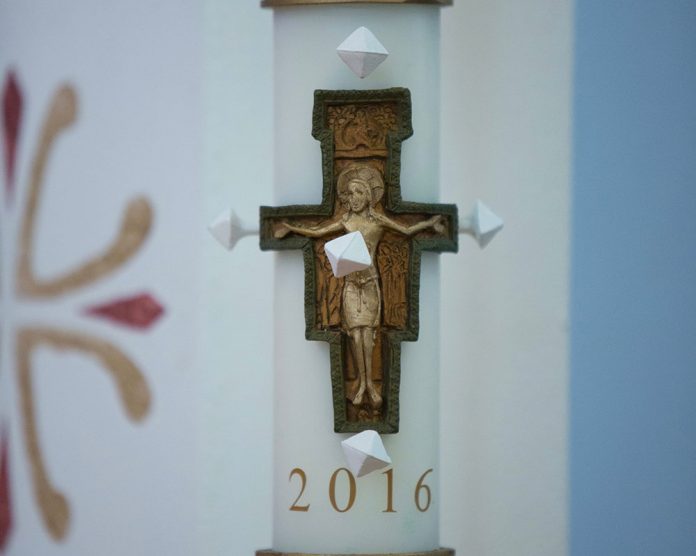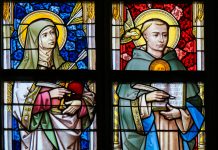
by Kathy and Mitch Finley
Think back to when you were growing up. Then, in several different ways, complete this statement: “We always ___.” You’ve just named some powerful traditions in your family, your domestic church, whether they were religious or not.
The word tradition implies the handing over (or across generations) of certain practices for safekeeping, although each generation invents its own traditions as well. Our traditions are those ways in which we mark what is important to us, including our faith. For example, there are certain times and experiences that we consider “holy ground”—just as Moses was told to take off his shoes as he approached the burning bush because it was holy ground.
Our Daily Traditions
Traditions in our families mark the holy times that happen every day—such as nightly prayers, meals together, or a blessing by parents just before bed or before heading out for the day’s school or work. The tradition of a nightly blessing is something we have encouraged new and not-so-new parents to adopt. There is something comforting and naturally reflective about being tucked in and reminded of God’s love and a parent’s love at the same time. Holy indeed.
No tradition is more familiar than the family’s daily mealtime. In addition to grace before the meal, there are plenty of potential traditions associated with a family eating a meal together. Some families light a candle to remind them that Christ is the light of the world and is present when they come together. Other families have each person share a high point and a low point from the day.
In a classroom, some students may have had these experiences, while others may not experience eating together as a family at all. If you ever have snacks in the classroom, sharing them can be a time to give all the students at least a “taste” of prayer before and after a meal.
Our Annual Traditions
Besides the daily holy times, there are many times of the year that offer opportunities for traditions. For example, many parents celebrate the first day of school—complete with new clothes or uniforms and new school supplies—by taking a picture of their children. Many families include a blessing for the coming school year and may even gift-wrap the school supplies to make them more special. Perhaps you have or can start a “first-day-of-class” tradition in your classroom.
Other new beginnings—such as a new pet, a new driver’s license, a new job, and going on a trip or leaving for vacation—are excellent times for a blessing or prayer. Some families bless each room of a new house; some families do a house blessing each year on the feast of the Epiphany. You can bless your classroom.
Birthdays are powerful times for traditions: birthday cakes or pies, blowing out candles, good wishes, singing, presents, and perhaps special meals. A great idea for small children is to have them celebrate a new privilege and a new responsibility with each passing year. For example, the just-turned four-year-old can go alone to the end of the block and back, but he’s also expected to feed the cat or make his bed. You can develop a birthday ritual for your students.
Our Holiday Traditions
This time of year is especially rich with holiday traditions that remind us of God’s presence in our midst: lighting the candles of the Advent wreath; opening the Advent calendar windows each day of December; celebrating St. Nicholas’ day on the eve of December 6 by putting out shoes and finding a treat the next day. This is a time of signs and wonders.
The traditions of when and how we decorate the house, where the Christmas tree is set up, and how we give presents to one another and how and when we open them speak plenty about what is important to us as a family. This is also a time to gather with extended family and to appreciate, again, how we are part of a much larger community.
In the midst of these rich experiences, we want to make sure that the focus is on the “reason for the season,” and so the nativity scene should take center focus, if possible. The infant Jesus should wait until Christmas Eve, if possible, to join Mary and Joseph, the shepherds, and others in the crèche. When you place the infant Jesus in the manger, gather around and sing a song or offer a prayer and read the infancy narrative (see Matthew 1 and 2 and Luke 1 and 2). Whatever your class or family does at this important time of year helps young and old better understand how we can find God’s presence right in our sacred traditions.
Our Ethnic Traditions
A family’s ethnic background(s) can enrich faith celebrations in the home throughout the year. Ethnic traditions have the power to connect us to our family stories, and these stories constitute our roots and deepen our sense of personal identity. Ethnic traditions often find expression liturgically as well, in the context of parish community. They also are rich opportunities for catechesis. Examples include the feasts of Our Lady of Guadalupe (Hispanic), St. Patrick (Irish), St. Benedict the Moor (African), and St. Anthony of Padua (Italian). Perhaps the feast of recently canonized St. John Paul II will become an annual celebration for Polish-American Catholics. Of course, for all of these and many more, the major holidays—Easter and Christmas—often include traditions with ethnic origins.
Already Holy
Our traditions do not make us holy. Rather, they celebrate and remind us of the holiness that is already there in our domestic church.
When the children in your family or in your classroom become adults and are asked what they recall that they always did, what do you think they will recall?
For Catechists to Consider
1. What cultures are represented in your class and how can you utilize that richness in your classroom (e.g., Las Posadas)?
2. Tell the story of St. Francis and the first crèche (see tinyurl.com/jvjs7ke).
3. Ask your students to describe traditions in their immediate families and extended families. Their descriptions can be a rich resource of tradition ideas for one another.
For Parents to Consider
1. What are some of the traditions you experienced growing up that you would like your children to remember?
2. What are some of the practices that you could add to your family’s traditions today, like the Advent wreath or a birthday cake for Jesus?
3. Remember that a “holy” family doesn’t mean a perfect family. Our messiness and being able to laugh at our mistakes are part of the holiness in the domestic church.
Kathy and Mitch Finley have been speaking and writing about the domestic church for the past 30 years. Visit their website at mitchandkathyfinley.com.
Copyright 2014, Bayard, Inc. All rights reserved. This article is protected by United States copyright and other intellectual property laws and may not be reproduced, rewritten, distributed, redisseminated, transmitted, displayed, published or broadcast, directly or indirectly, in any medium without the prior written permission of Bayard, Inc.




